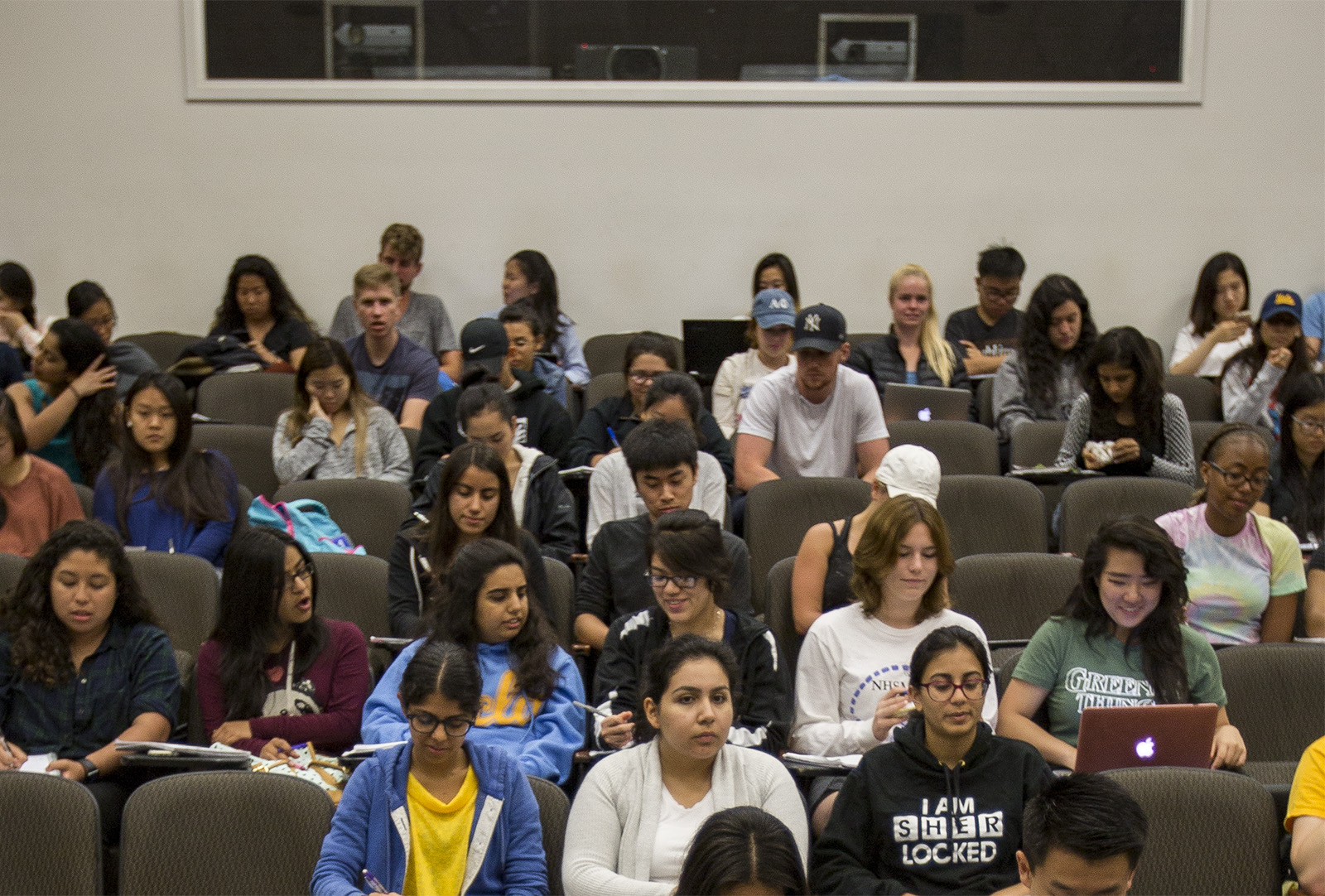Selby Kia: Absolute grade scale could curb bell curve’s detrimental effects

Bell curves do not account for the variety of circumstances students face. Professors might not be able to accommodate every student’s experience, but implementing an absolute grading scale would give disadvantaged students a better shot at securing the grade they deserve. (Kristie-Valerie Hoang/Assistant Photo editor)
By Selby Kia
Oct. 16, 2017 1:16 a.m.
At UCLA, for whom the bell curve tolls depends on the professor and not much else.
The bell curve, a statistical measure of grading, assesses students’ academic performance relative to other students in the class. This method of grading involves distributing grades along a bell-shaped curve, ensuring a small, top percentage of students get A’s, the majority middle tier gets B’s and C’s and the remaining few inevitably get D’s and F’s. This contrasts with the absolute scale model, in which any grade above 90 percent is an A, 80 percent is a B and so on.
While the bell curve form of grading can be helpful in comparing student performance, it only assesses how well students understand the material relative to their peers and not necessarily how well they understand the material overall. This defeats the purpose of learning for the sake of learning, but a good number of UCLA professors still use a bell curve model to grade their classes.
Instead, professors should use an absolute scale to grade their courses with no predetermined percentile cutoffs for letter grades. This would mean students would get the grade they earn, instead of being judged based on their classmates’ performance. Of course, professors would still need to adjust grades by the average score if raw exam scores are too low for them to give any students passing grades under an absolute scale. Doing so would incentivize students to learn the material without feeling like an A or B is beyond their reach.
In some circumstances, the bell curve can be downright unfair – something Anshul Aggarwal, a third-year computer science and engineering student, knows all too well.
In Aggarwal’s Computer Science M152A: “Introductory Digital Design Laboratory” class only 10 percent of students get A’s. The problem? If only 10 percent of the 30 students in the lab can get A’s, only three students can get an A, regardless of the other students’ raw scores. Under these circumstances, a 95 percent raw score would only earn the student a B or B- at best.
Even in classrooms with a good deal more than 30 students, such grading limits students’ potentials. Michael Tsiang, a statistics lecturer, said he believes grading must accommodate the different types of students in the university.
“It doesn’t make sense to compare people who walk in already knowing the material with those who have never seen it before and have math anxiety,” he said. “It’s an unfair comparison.”
Tsiang said he does not use predetermined percentile cutoffs in his grading system, which he added is the way he himself would like to learn.
“If the course is well-designed, then if you focus on the learning, the grade will come,” he said. “If you master the material, you should get an A.”
Proponents of the bell curve grading system might say it encourages students to compete against each other, ensuring the top students get rewarded. However, putting stringent percentage caps on the number of A’s and B’s in a class pits students against each other and can discourage students from collaborating.
To this end, Kim Aquino, a second-year environmental science major, said she thinks bell curves instead drive students to seek help by any means necessary.
The reality is students face a wide variety of circumstances a bell curve cannot completely account for. Students who may have taken the Advanced Placement or International Baccalaureate version of a course in high school will have an edge. And then there are students who do not have access to textbooks and tutoring, as well as those struggling with personal issues. While it is impossible for professors to take into account every student’s individual experience, an absolute scale would help disadvantaged students get a fair shot at receiving an A.
Of course, neither version of grading is invariably right. But the fact remains that students with advantages sway the curve much more in a class of 50 than in a class of 200. And this is a major downside of the bell curve model.
As such, professors should implement a flexible absolute curve model with less stringent percentage caps on the grades assigned. This would provide a more accurate picture of student performance and could make exam grading more fair. When professors make exams too difficult, the curve can make up for it. An absolute grading model would still do this, but without the disheartening percentage cutoffs.
Tsiang said he does not necessarily think there is one right way to grade but said his method of grading has worked for him, and his students told him the exams reflect their understanding of the material.
On whether or not to grade on the bell curve, the Office of Instructional Development emphasizes the importance of considering the desired atmosphere in the classroom, saying that grading based on peer ranking can create hostility among students while an absolute scale can encourage them to collaborate. While choice of grading method is left to the professors, the University of California’s Academic Senate regulations state that grades should be based solely on an evaluation of the student’s achievement of the course goals.
No two students have the same academic or personal background. Instead of defaulting to the bell curve, professors should first take into consideration class size and subject matter, especially in science, technology, engineering and mathematics courses in which prior exposure to the material can vary widely between students.
Curving down does not assess students’ abilities to learn. Rather, it measures students’ ability to outperform each other – turning a supposedly helpful curve into nothing more than a cliff.


